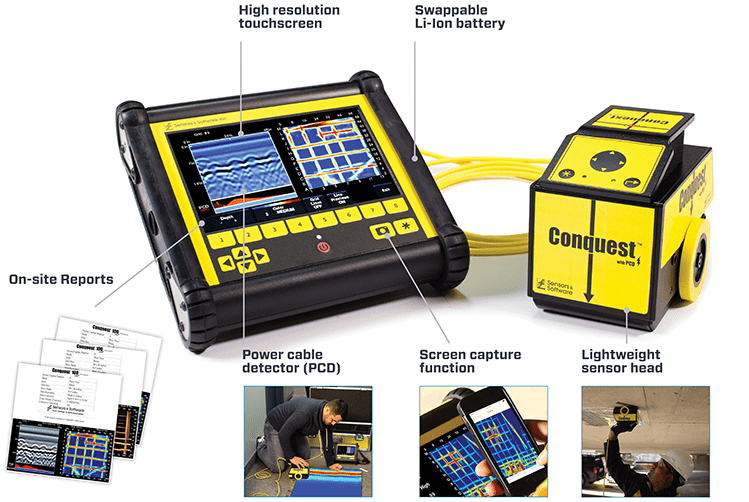Local RainierGPR Service Areas for Accuracy Concrete Scanning
Local RainierGPR Service Areas for Accuracy Concrete Scanning
Blog Article
Enhancing Job Planning and Execution With Advanced Concrete Scanning Methods
In the world of job planning and execution, foresight and accuracy are crucial components that can make the difference between success and troubles. Advanced concrete scanning techniques have arised as an advanced tool readied to raise the standards of task management within the building industry. By taking advantage of sophisticated technology, these strategies provide a look right into the architectural integrity of a structure even before the first brick is laid. The effects of such innovations are extensive, guaranteeing a paradigm change in exactly how projects are approached and provided.
Benefits of Advanced Concrete Scanning Strategies

Improved Accuracy in Job Evaluations
Enhancing project evaluations with sophisticated concrete scanning strategies considerably boosts the accuracy and reliability of building assessments. By using sophisticated scanning technologies such as ground-penetrating radar (GPR) and 3D imaging, task teams can now get thorough insights into the problem of concrete frameworks, identifying potential flaws or weak points that may not show up to the nude eye. This enhanced degree of precision in project evaluations enables building experts to make more enlightened decisions relating to repair and maintenance strategies, leading to boosted overall task end results.
Additionally, the increased accuracy in task analyses attained through sophisticated concrete scanning strategies helps in decreasing the threat of unforeseen problems throughout the building phase. By proactively spotting hidden anomalies within concrete structures, such as rebar rust or gaps, job teams can resolve these problems early, preventing expensive delays and remodel later on in the job lifecycle. Inevitably, the boosted precision in job assessments helped with by innovative concrete scanning techniques contributes to greater efficiency, cost-effectiveness, and high quality in building and construction projects.
Very Early Recognition of Architectural Obstacles
Very early detection of structural challenges plays a critical role in guaranteeing the integrity and security of concrete frameworks throughout the construction procedure. Identifying prospective problems at an onset permits for timely intervention, protecting against costly rework, routine hold-ups, and safety and security dangers. Advanced concrete scanning strategies, such as ground-penetrating radar (GPR) and 3D imaging, allow task groups to uncover hidden problems, voids, support design disparities, and various other anomalies that might jeopardize the structure's stability.
By applying these strategies during the preparation and implementation stages, building professionals can proactively resolve architectural difficulties before they intensify right into significant problems. For example, spotting insufficient concrete cover over reinforcement bars early on can stop rust and architectural weakening over time - RainierGPR Service Areas. Moreover, determining variants in concrete thickness or density can help optimize product use and make certain uniform stamina residential properties across the framework

Ultimately, very early recognition of architectural obstacles via advanced concrete scanning not just boosts the general high quality and longevity of the construction but likewise adds to a more secure developed setting for owners and customers.
Improved Safety And Security Actions in Construction
The application of robust safety methods is necessary in the construction sector to reduce risks and read review protect the well-being of stakeholders and employees. Building and construction websites are naturally dangerous atmospheres, with prospective dangers ranging from falls and tools breakdowns to architectural failures. To boost safety and security procedures, building business are significantly adopting technological developments such as wearable devices that monitor employees' crucial indicators and spot possible health issues in real-time. Furthermore, making use of drones for site surveillance permits normal safety and security assessments without placing workers in harm's means. Safety and security training programs have likewise advanced to include online truth simulations that offer hands-on experience in managing emergency situation circumstances. Furthermore, the assimilation of synthetic knowledge in safety and security management systems makes it possible for proactive identification of potential dangers, enabling prompt interventions. By focusing on security with the incorporation of sophisticated modern technologies and detailed training programs, construction projects can substantially decrease mishaps and create a secure functioning environment for all included - RainierGPR Service Areas.
Streamlining Job Administration Processes
To maximize operational performance and guarantee project success in the Extra resources construction market, a focus on streamlining project monitoring procedures is vital. By implementing efficient project management processes, building and construction tasks can lessen hold-ups, decrease expenses, and boost general efficiency.

Verdict
To conclude, the utilization of sophisticated concrete scanning techniques offers various advantages for project preparation and implementation. These methods offer improved accuracy in project evaluations, very early identification of structural challenges, improved security actions in construction, and streamlined job administration procedures. Including these methods into project operations can ultimately lead to a lot more efficient and effective outcomes in construction jobs.
Inevitably, view it now the enhanced precision in task assessments assisted in by sophisticated concrete scanning techniques contributes to better effectiveness, cost-effectiveness, and quality in building tasks. RainierGPR Service Areas.
To maximize operational efficiency and ensure job success in the building industry, an emphasis on improving job management procedures is crucial. By carrying out effective job monitoring processes, building and construction tasks can minimize hold-ups, reduce costs, and improve general performance. By simplifying project management procedures through modern technology assimilation, clear interaction, and data-driven techniques, construction projects can achieve better effectiveness, cost-effectiveness, and successful results.
These techniques supply better precision in task evaluations, early recognition of architectural obstacles, improved safety measures in building and construction, and structured task monitoring processes.
Report this page